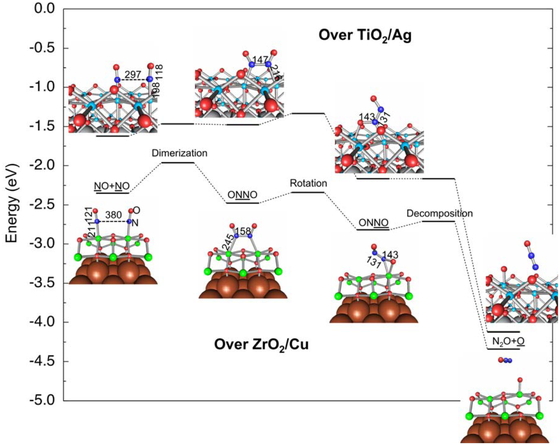Article ID: 2018-0039
Article ID: 2018-0039
金属表面に担持した酸化物超薄膜は特異的な触媒活性を示すことがある.我々はこのような酸化物/金属接合系の自動車排ガス浄化触媒としての可能性に着目し,NO-CO反応素過程を平面波基底密度汎関数計算により検討してきた.ここではTiO2/AgとZrO2/Cuの二つの格子整合系に関する計算結果を紹介する.いずれの系でも,金属からNOへの電子供与により,NOがカチオンサイト上で吸着活性化され,二量化してONNOとなる.ONNOはN2OとOに分解し,さらにN2OがN2とOに分解する.表面に残ったOはCOと反応してCO2を生成し,触媒サイクルが完結する.活性化障壁や吸着エネルギーの計算値から,TiO2/AgよりもZrO2/Cuが触媒として優れていると予想される.物質間の差を生じる要因として,カチオン正電荷やカチオン間距離の差が挙げられる.

Schematic representation of a core-shell catalyst and an oxide/metal model system.

Oxide/metal slab models.

Projected density of states (PDOS) for TiO2/Ag (top) and ZrO2/Cu (bottom) [10,11]. Reproduced with permission from the Chemical Society of Japan and Springer.

NO adsorption on (a) TiO2/Ag and (b) ZrO2/Cu. Energies are referenced to gaseous NO (N–O: 117 pm and 1923 cm–1).

NO + NO → N2O + O reaction over TiO2/Ag and ZrO2/Cu. Energies are referenced to gaseous 2NO. Distance in (pm).

Transition states of N2O decomposition over (a) TiO2/Ag and (b) ZrO2/Cu.

Transition states of O + CO reaction over (a) TiO2/Ag and (b) ZrO2/Cu. Distance in (pm).